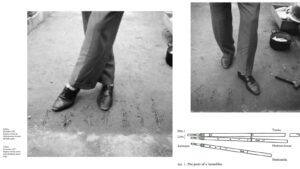I love this picture. I love the sense that this woman has stolen a moment for herself, carved it for herself out of the well-mapped and ill-considered humdrum routine with which the world compensates her effort and her presence. She has paused, shifted her focus, and made this instant irreversibly her own with the power of her attention.
This comforts me. It comforts me on her behalf and comforts me for myself. I am comforted to see that done, if that is what’s being done here, because it reminds me that I can do it myself—that one’s attention can reshape one’s relation to what’s there. It can change what one is connected to and how. That this can be up to her, up to me, up to anyone. There is a power there, and it’s a power I feel I’ve also invoked by looking with attention at a picture of someone looking with attention at a picture.
But this is not the only power one can find in this photo. By and large I find that readings of an image like this, of a working Black woman in the late 40’s “stealing” a glance at “high art,” take a more politicized, historical approach. This woman is a black service worker in 1948: her life is likely to have been one of daily injustice and banal dehumanization in which she might never see the inside of the MoMA or any other such institution if she wasn’t there, cleaning, after hours. It’s possible that Henle intended this image to highlight the disparities rampant in the situation it portrays, from the colonial artificiality of the figural relief on its blank wall to the stark contrast of idealized, headless nudes limning a breathing and looking woman.
I see these things, but I come away nonetheless with the conviction that I should see the person in the picture first as a person whose life may have been hard but who may have been able to see something beautiful in a way that no-one else did. I hope she looked forward to her job, just like I hope the people who clean the MoMA these days do.
But I’m often reluctant to offer up this kind of interpretation. When I have, I’ve found myself shot down as naively or even disingenuously refusing to see whatever’s on the table as an opportunity for systemic critique. What seems to me to be an intuitively respectful and empathetic appraisal is taken to be not merely useless but destructive, a distraction from the “real” significance of an image, event, or other object of interpretation. I understand the practical toothlessness of “hoping someone looks forward to their job.” But the more I talk with people who see a totalizing, systemic analysis as the only truth-bearing way to relate to the particulars of experience, especially our experiences of other people, the more I realize that such analysis not only rejects but erases personal, consciously limited (one might say “subjunctive”) understandings of the people involved.
Understandings like these are not a call to action. They are a call to ongoing attention. A call to attention that gives one a power over oneself and one’s relation to the world that this woman in the MoMA could very well be (and I hope was) employing in the very moment that picture was taken.
Simone Weil describes attention as a focused presence-with-something, devoid of preconditions, an emptying-out of the self (kenosis, really) to receive the other without presuming anything about the understanding I may receive of it, and in a manner that cannot act, because to act while accepting would be coercive. This is a sort of perfectly ‘unmixed’ attention—one that simply waits, however actively, upon revelation. It seems like the opposite of an attention that defines the particulars before it according to a canon of historical patterns. My visceral objection is to the latter, but am I not doing the same sort of thing by looking at this picture of a woman looking at a picture and hoping for her? If hope itself is not a conclusion, as I would argue, then what conclusions does it rely on?
My tentative answer is that in attending to this picture I have accepted—have concluded—that this is a picture of a person. In the same way that I can look at this photograph of her, she was also looking at a sculpture, a sort of picture, when this photograph was taken in 1948. In the same way that I can attend to something with enjoyment, she could. And I hope that she made, of that moment’s looking, something good for herself—that her attention was her own, her understanding her own, and her enjoyment her own. My regard for her can be subjunctive, both epistemically humble in a manner echoing Weil and confident in its hope that she enjoys attending to her world, because she is a being that can and should. Taking her to be this kind of being makes room in my understanding, not room in the total way Weil makes room, but room for something, room shaped a certain way because a person is involved, but which I cannot map or fill in on my own. In my understanding of the woman in the picture, I have to stop there, because she faces away from me and I do not know her, do not know the fullness she could bring to the room I have made in my attention for her. It hangs as hope. My hope for her is the result of attention that presumes exactly and only one thing: her humanity.
This kind of attention always invites fulfillment in further attention, further holding-open of space for its object to fulfill with the reality of itself. I would say this goes on forever, that we are always holding space in our understanding and that the things we attend to are always unfolding into that space. And a continual holding-open does not imply that nothing is formed there, only that understanding gained begets more room to be made, more hope that what will fill it is the best thing that could. Such attention can eventually inform a call to action, but not with the same immediacy as attention that reduces its object to a symbol in (and of) a system, evoking the mechanism of that system and how it can be manipulated.
In the months that followed George Floyd’s murder last summer, I remember noticing that no-one talked about the fact that he was a Christian. There are videos where he, himself, tells us what he thinks Black people in America need—Black men in particular. But what he thought and said about the very issues he became central to isn’t talked about. In the midst of the media storm about his death and its significance, I had to dig to find anything about him and his life that wasn’t already drastically reframed.
I’m not trying to bury the lede here: I’m saying that this conflict of attentions has been present for a long time and still is, maybe even moreso. Attention to a person as a symbol is a different kind of attention than the one I’ve advocated above: attention to them as a person that requires this deliberate making-room. I would say it’s a less complete, less honest type of attention, one that degrades its regard for its object but leads to a more actionable, constructive relation to that object precisely because it can be presumptive, can act at the same time as looking. But it is not making-room, it is making-fit. Can we value both kinds of attention? Shouldn’t we? Is attention that’s been streamlined, degraded by the necessities of history, valuable on its own terms or only towards some end? Is attention that actively attends and waits to be fulfilled always retrograde to actionable understanding? Do these questions solely frame an unfortunate tradeoff wherein the necessity justifies the degradation, or is there another way to see it? Am I wrong to want to preserve and laud attention for the sake of its object alone, especially when that object is another person? Am I wrong to look at this picture and, first and foremost, hope this woman looked forward to her job each night?




